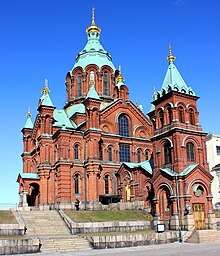
Back ثقافة فنلندا Arabic Cultura de Finlandia Spanish Suomalainen kulttuuri Finnish Culture finlandaise French Cultura finlandese Italian フィンランドの文化 Japanese ფინეთის კულტურა Georgian Cultura da Finlândia Portuguese Культура Финляндии Russian Kultura e Finlandës Albanian
This article needs additional citations for verification. (August 2020) |


| Part of a series on the |
| Culture of Finland |
|---|
 |
| People |
| Languages |
| Mythology and folklore |
| Cuisine |
| Festivals |
| Religion |
| Literature |
| Music |
| Sport |
The culture of Finland combines indigenous heritage, as represented for example by the country's national languages Finnish (a Uralic language) and Swedish (a Germanic language), and the sauna, with common Nordic and European cultural aspects. Because of its history and geographic location, Finland has been influenced by the adjacent areas, various Finnic and Baltic peoples as well as the former dominant powers of Sweden and Russia. Finnish culture is built upon the relatively ascetic environmental realities, traditional livelihoods, and heritage of egalitarianism (e.g. Everyman's right, universal suffrage) and the traditionally widespread ideal of self-sufficiency (e.g. predominantly rural lifestyles and modern summer cottages).
There are cultural differences among the various regions of Finland, especially minor differences in dialect. Minorities, some of which have a status recognised by the state, such as the Sami, Swedish-speaking Finns, Karelians, Romani, Jews, and Tatars, maintain their cultural identities within Finland. Many Finns are emotionally connected to the countryside and nature, as large-scale urbanisation is a relatively recent phenomenon.

© MMXXIII Rich X Search. We shall prevail. All rights reserved. Rich X Search